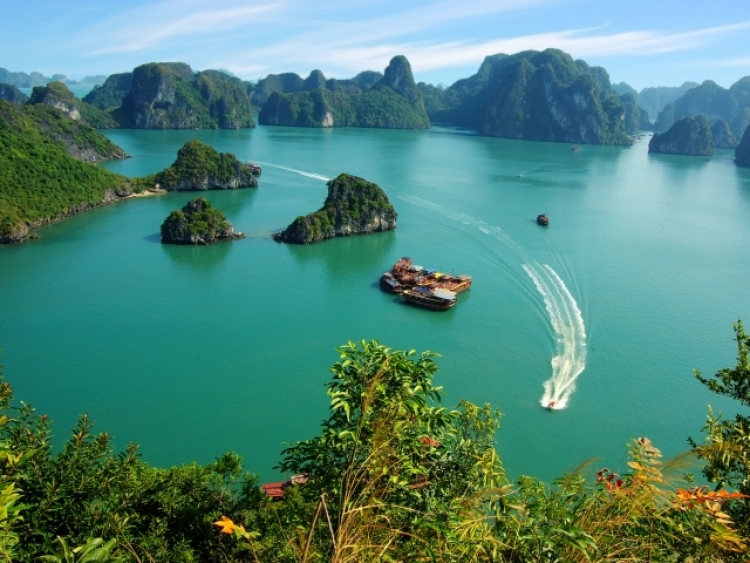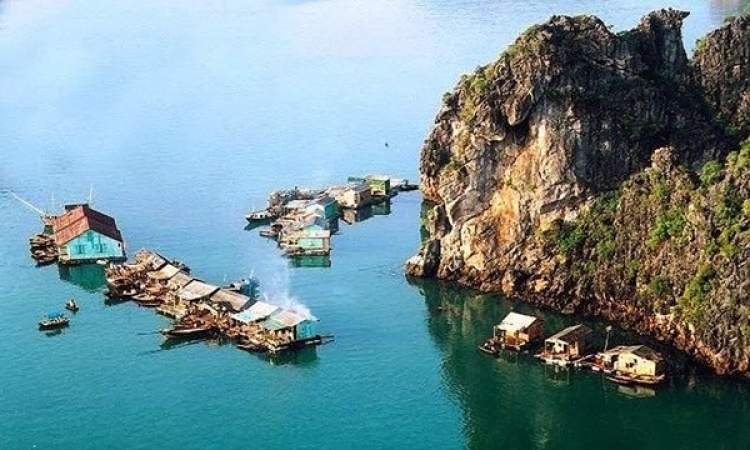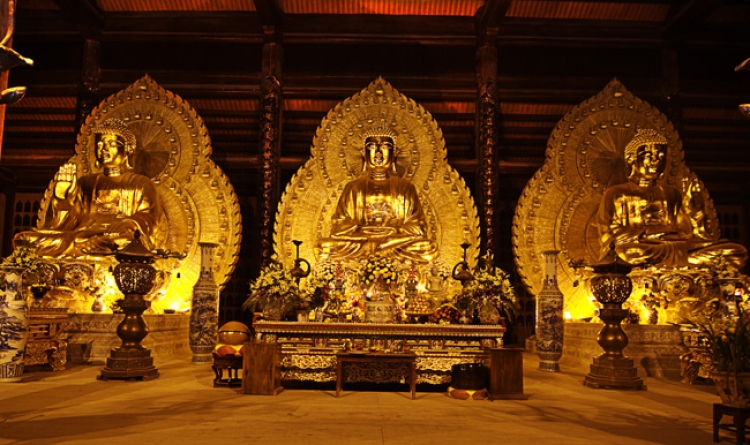
Heritages (5)
Four best features of Trang An Scenic Landscape Complex
Written by Asia Pacific Travel TeamThe property also includes Hoa Lu, the old capital of Vietnam in the 10th and 11th centuries AD, as well as temples, pagodas, paddy-field landscapes, with villages and sacred sites.
Its four best features are
1. Mixed natural and cultural heritage

Trang An Scenic Landscape Complex is the first site in Vietnam to receive UNESCO mixed natural and cultural heritage world recognition.
The Ninh Binh provincial People’s Committee will hold a three-day celebration on January 22-24, 2015 at Bai Dinh Pagoda in honour of the event, to include the award presentation ceremony.
The complex spans a total area of 12,000 hectares. It symbolizes the magic, mystery and majesty of the natural world.
2. Most caves in Vietnam
With 48 caves, Trang An now has the most caves in the country. Each cave with its different name is attached to a story such as Sinh, Dia Linh, Ba Giot, Nau Ruou and Quy Hau.
The longest cave is 2km. Every cave connects to each other, forming a circle. Tourists visit the caves by boat.
3. Most unique tree in Vietnam

The 1,000-year-old Cay Thi in Khong temple is considered the most unique tree in the nation.
Tourist must sail by boat through 13 majestic caves that spread 13 km to Khong temple.
4. Most spectacular bird sanctuary

The Thung Nham bird sanctuary spanning an area of 334.2 hectares consists of 46 kinds of birds, some of them are listed in the Red Book of endangered species.
Ha Long Bay, Son Doong Cave named as the most breathtakingly beautiful places
Written by Asia Pacific Travel TeamIn the list for 2015, Ha Long Bay in northern Quang Ninh province ranked third while the Son Doong cave in central Quang Binh province, in the seventh place.
Located 165 km from Hanoi, the capital of Vietnam, Ha Long Bay is an area comprising 1,600 islands and islets.
The majority of these land masses have not been touched by humans and have managed to retain their beauty since their creation. It is this that enabled it to be listed by UNESCO as a World Heritage Site, GlobalGrasshpper said.
Meanwhile, located approximately 500km south of Hanoi, the Son Doong cave, the largest in the world, is more than 200m wide, 150m high, and about 9km long. It houses a jungle and a river, and could fit a 40-storey skyscraper within its walls.

For centuries, men have mulled upon the existence of hollow Earth – a theory that states that the Earth is hollow. If hollow Earth did exist, than the Son Doong cave would be a testament to its existence. The cave is so large that humans exploring them would look like ants. The Son Doong cave is evidence of the world’s beauty, inside and out, the website said.
Ha Long Bay's beauty seen through the lens
Written by Asia Pacific Travel TeamDesignated as a UNESCO world heritage site 20 years ago, Ha Long Bay is one of Viet Nam's most popular tourist attractions.
Official recognition was granted in 2000, and a year later, Ha Long Bay outranked 261 other landscapes around the globe to become one of seven new natural wonders of the world.
Since then, Ha Long Bay has welcomed nearly 25 million visitors, turning Quang Ninh into a tourist magnet.
Located 165km from Ha Noi, Ha Long Bay covers a 43,400ha area, including more than 1,600 islands and islets, most of them uninhabited.
UNESCO describes the bay as a "spectacular seascape of limestone pillars" and an "ideal model of a mature karst landscape developed in a warm and wet tropical climate."
Visitors to Ha Long Bay can enjoy the beach at Ti Top Island, discover Surprise Cave,and challenge themselves with water sports. They can take a one- or two-night tour on boats to sleep on the water and go squid fishing at night.
A seaplane service launched last month offers a new way to experience Ha Long Bay. Flying over the sea, tourists may view the islands from a height of 150 to 3,000 metres, which is a new experience for them.
 |
| A view of the Ha Long Bay from the sky. |
 |
| Thousands of islands and islets rise from the sea. |
 |
| Bai Chay beach by the sea. |
 |
| A view of Ha Long Bay from the entrance of Bo Nau Cave. |
 |
| The Trong Mai Islets (rock of kissing cocks). |
.jpg) |
|
| Boats on Ha Long Bay. |
 |
| Various kinds of cruises provide one- or two-night tours around the year. |
 |
| Cruises dock at the wharf. |
 |
| Tourists take a tour around a fishing village in Ha Long Bay. |
Trang An Scenic Landscape Complex - A convergence of cultural and natural values
Written by Asia Pacific Travel TeamBeing endowed with a beautiful landscape, Trang An Scenic Landscape Complex in Ninh Binh Province in Northern Viet Nam is called as an “Ha Long Bay on land” with numerous caves, mountains, valley, trees and historic relics.
On 23 June 2014, Trang An has just been inscribed in the UNESCO’s World Heritage List, proudly being the Viet Nam’s first site to be acknowledged as a mixed natural and cultural heritage.
Covering an area of 10,000ha in Hoa Lu, Gia Vien and Nho Quan districts and Ninh Binh City, Trang An Scenic Landscape Complex includes Trang An Eco-tourist Site, Tam Coc- Bich Dong Landscape and Hoa Lu Ancient Citadel.
With a spectacular landscape of limestone karst peaks permeated with valleys, some of which are submerged, and surrounded by steep, almost vertical cliffs, Trang An Eco-tourist Site is considered as an outdoor geological museum because it is entirely surrounded by bow shaped limestone mountain ranges lying on a delta wetland area.

According to current statistics, Trang An has 48 grottoes and caves alternating with 31 large and small valleys. Each valley is a various charming beauty bringing a multi-colorful picturesque landscape. Here is evaluated as an area of rare and unique natural beauty of the world with around 500 species of flora, 73 species of birds and 41 species of other animals, and is renowned for its diverse ecosystem, unique natural beauty and geological characteristics.
Bai Dinh - the largest pagoda in Viet Nam and Southeast Asia is located in Trang An eco-tourism site belonging to Gia Sinh commune, Gia Vien District. The pagoda is promising to be a Buddhist center of the region.
In addition to Trang An Eco-tourist Site, Tam Coc- Bich Dong Landscape and Hoa Lu Ancient Citadel are in core zone of the heritage site. Located in Ninh Hai Commune, Hoa Lu District, Tam Coc-Bich Dong still remains primary natural features with unique architectures alternating with pagodas and caves such as: Tam Coc, Thai Vi Temple, Bich Dong Pagoda, Tien Cave, Mua Cave...

Not only serving as a cradle of civilization of ancient Vietnamese, Trang An also used to house the old capital of the Vietnamese feudal and independent state, Hoa Lu Ancient Citadel, more than 1,000 years ago. Hoa Lu Ancient Citadel is a national relic related to the three dynasties in feudal history of Viet Nam (Dinh, Le and Ly dynasties in the 10th and 11th centuries). This area consists of defense earthen walls, palaces, temples and shrines which make magnificent fairy scenery. According to old historical books, in 968, after defeating twelve armies of rebels and unifying the country, Dinh Bo Linh came to the throne as King Dinh Tien Hoang. He set up the capital in Hoa Lu and named the country Dai Co Viet. From 968 to 1009, six kings of the Dinh, Le and Ly Dynasties set up the capital there. In 1010, King Ly Thai To moved the capital from Hoa Lu (Ninh Binh) to Thang Long (Ha Noi). Since then Hoa Lu has remained the ancient capital.
Trang An Scenic Landscape Complex is a very unique example of human history, not only for Viet Nam but also for the region. It has a combination of both natural and cultural values.
In 2013, Ninh Binh tourism welcomed more than 4.5 million arrivals with total tourism receipts of VND 900 billions. It is expected that the provincial tourism receipts will increase rapidly after the recognition as the world’s mixed natural and cultural heritage of Trang An Scenic Landscape Complex.
Pham Thanh
8 Vietnam's world heritages charming beauty
Written by Asia Pacific Travel TeamBy 2014, following UNESCO’s recognition of Trang An as a mixed natural and cultural heritage of the world, Viet Nam has 20 world heritage properties including 05 cultural heritage sites, 02 natural heritage sites, 01 mixed heritage site, and other document and intangible cultural heritage properties.
1. Ha Long Bay

Located in the North-East region of Viet Nam, Ha Long comprises of the regions of Ha Long City, township of Cam Pha, and a part of the island district of Van Don. Ha Long Bay covers an area of 1,553 km2 and includes over 1,969 islands and islets of various sizes, 989 of which have been given names. The world heritage site is recognized with an area of 434km2 including 775 islands, forming a triangle with the island of Dau Go (Driftwood Grotto) to the west, the lake of Ba Ham (Three Shelter Lake) to the south, and the island of Cong Tay to the east.
Ha Long Bay is a great artwork of nature with a system of lively, mysterious and beautiful islands and caves containing important vestiges in the formation and development of the earth’s history and considered as the cradle of ancient Vietnamese. In addition, it is also a region of highly-concentrated biological diversity with many ecosystems of salt water-flooded forests, coral reefs, and tropical forests featuring thousands of flora and fauna species.
Ha Long Bay is not only recognized as world heritage (1994 and 2000), but also is voted as one of 7 new wonders of the world and always in list of the most beautiful bays of the world.
2. Phong Nha- Ke Bang National Park

Phong Nha- Ke Bang National Park with an area of 200,000ha, is located in Quang Ninh, Bo Trach, Tuyen Hoa and Minh Hoa districts (Quang Binh Province). It is considered as a huge geological museum of global values.
The karst formation has evolved since the Palaeozoic period (some 400 million years ago) and as such is the oldest major karst area in Asia. Subject to massive tectonic changes, the karst landscape is extremely complex, comprising a series of rock types that are interbedded in complex ways and with many geomorphic features. The karst landscape is not only complex but also ancient, with high geodiversity and geomorphic features of considerable significance. In April 2009, a group of cave explorers from British Caving Association conducted survey in this park and adjacent areas. The biggest chamber of Son Đoong is more than 8.5 kilometers in length, 200 meters high and 150 meters wide. In addition, Phong Nha- Ke Bang National Park also is home to a series of rare species in the list of Viet Nam and world Red Book.
3. The Imperial Citadel of Thang Long
.jpg)
Located in the heart of the capital of Viet Nam, the Imperial Citadel of Thang Long has total area of 18,395 ha including the Archaeological Site at 18 Hoang Dieu street and other remain relics such as Ha Noi flagpole, Doan Mon Gate, Doan Mon Gate, the House D67, Hau Lau Palace, North Gate, the wall and eight gates of royal step-over places of the Nguyen Dynasty.
The Imperial Citadel of Thang Long - a complex of relics are associated with the history of Thang Long - Ha Noi Citadel.
As a monumental building, the Thang Long Citadel was built during many historical periods and became one of the most important monuments of Viet Nam. Through many ups and downs of history, the Imperial Citadel of Thang Long has quietly changed excluding Forbidden City.
At the Imperial Citadel of Thang Long, archaeologists have unearthed a large number of royal pottery items over many periods.
The archaeological findings such as coins and ceramics from China, Japan, West Asia… are proofs of a cultural exchange center in the region in the past.
4. Citadel of the Ho Dynasty

Situated in communes of Vinh Tien, Vinh Long, Vinh Quang, Vinh Yen, Vinh Phuc, Vinh Ninh, Vinh Khang, Vinh Thanh and Vinh Loc Town (Vinh Loc District), Thanh Hoa Province, the Citadel of the Ho Dynasty was constructed of large limestone blocks in the area between the Ma and Buoi rivers. The citadel of the Ho Dynasty was built in 1397 by Ho Quy Ly who was the highest-ranking mandarin of the Tran Dynasty at the time. It was also as the the capital of Dai Ngu (the country name of Viet Nam in the Ho Dynasty).
The citadel of the Ho Dynasty is considered as a unique stone citadel in Viet Nam, East Asia and Southeast Asia of the late 14th – early 15th century.
5. Complex of Hue Monuments

Located along the Perfum River, the Complex of Hue Monuments was built by Nguyen Dynasty from the early 19th century to the first half of the 20th century.
Becoming the first world heritage in Viet Nam in December 1993, the Complex of Hue Monuments is an outstanding demonstration of the power of the vanished Vietnamese feudal empire as well as an symbol of an eastern feudal capital in the early 19th century.
These architectural works of a high cultural and historic value include Kinh Thanh Hue (the Hue Capital Citadel), Hoang Thanh (the Royal Citadel or Imperial City) and Tu Cam Thanh (the Forbidden Citadel) clustered together, symmetrically placed along the longitudinal axis and facing to the south.
Besides splendid palaces, majestic tombs and beautiful landscapes, Hue Ancient Capital still remains intangible and tangible cultural values representing for the wisdom and spirit of Vietnamese.
6. Hoi An Ancient Town

Situated on the north bank of Thu Bon River, Quang Nam Province, Hoi An Ancient Town was a South-East Asian trading port dating from the 15th to the 19th century.
Remaining many religious buildings (pagodas, temples, churches, ancient wells, tombs, assembly halls, etc...), Hoi An Ancient Town is a well-preserved example of a traditional Asian trading port, is an outstanding material manifestation of the fusion of cultures over time in an international maritime commercial centre.
Over centuries, many traditional foods, customs, ceremonies, cultural activities and religious beliefs have been still preserved. In 1999, Hoi An Ancient Town was recognized as the World Cultural Heritage.
7. My Son Sanctuary

Located in Duy Phu Commune, Duy Xuyen District, Quang Nam Province, My Son was built for the first time in the 4th century under the reign of Bhadravarman for worship of God Shiva-Bhadresvara. But later on, the temple was destroyed. At the beginning of the 7th century, King Sambhuvarman had rebuilt and rebaptized Sambhu-Bhadresvara. My Son Sanctuary was found in 1885. Of the 225 Cham vestiges that was founded in Viet Nam, My Son possesses 70 monuments and 32 epitaphs, the content of which is still being studied.
8. Trang An Scenic Landscape Complex

Trang An Scenic Landscape Complex was recognized as Viet Nam's first mixed heritage by UNESCO on 23 June, 2014. Covereing an area of 61,720 ha in Hoa Lu, Gia Vien and Nho Quan districts and Ninh Binh City, Trang An Scenic Landscape Complex includes Trang An Eco-tourist Site, Tam Coc- Bich Dong Landscape, Hoa Lu Ancient Citadel and the Hoa Lu primeval forest.
Being called as an “Ha Long Bay on land” with numerous caves, mountains, valley, trees and historic relics, Trang An Scenic Landscape Complex is considered as an outdoor geological museum because it is entirely surrounded by bow shaped limestone mountain ranges lying on a delta wetland area.








































































































